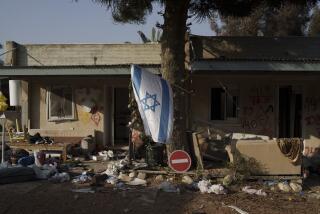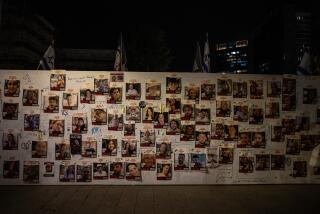MIA in Mumbai
- Share via
Those who live in Tel Aviv, New York or London need not fear a Mumbai episode. If 10 infantry-trained terrorists were to attack those cities, local police with their own hostage-rescue teams would quickly deal with them.
But in India, the reality is that local police cannot be expected to react usefully to a terrorist attack, or indeed any form of armed attack, as they would in many other countries -- for example, sealing off the area and summoning help. Instead, Mumbai and India’s other mega-cities are policed by semi-illiterate constables who deal only with petty crime as they make their rounds, drinking free tea in cafes and accepting small gifts from shopkeepers for chasing away intrusive beggars. They hardly ever stop inter-religious or inter-caste violence and are reluctant to engage anyone with a firearm.
Accordingly, in Mumbai there was no police cordon around the huge Taj Mahal Palace & Tower hotel nor the quite small Nariman House of the Jewish Chabad-Lubavitch group during the sieges, so that terrorists could have been reinforced or could have escaped.
It’s not that India is unfamiliar with terrorism. According to recent data from India’s Home Ministry, about 7,000 Indians have been killed in terrorist incidents since 2004 -- mostly but not exclusively by Muslim extremists. Obviously the nation has needed a much better-educated, better-paid, better-trained national anti-terrorist police unit for years, but none has been established. Thus the forces available to fight the terrorists in Mumbai were pathetically inadequate in quantity, quality or both.
That was clearly true of Maharashtra’s state anti-terrorism squad, which is headquartered less than 10 minutes from the sites of the attacks but which had a total of 35 officers -- and fewer than 15 on duty. This, to protect a state population of 96 million, 18 million in Mumbai alone. The squad’s commander, Hemant Karkare -- who was killed early in the attacks -- was a 54-year-old investigator, not a fighter even at the level of an ordinary infantryman.
By contrast, India’s National Security Guards, formed in 1985, are well trained. But the guards are a military-style commando assault force, with no real experience in civilian hostage rescue, even though that is one of their official missions. With 7,500 trained men, they could have responded adequately in a military way, if only someone had managed to call enough of them in quickly.
The first terrorist attack was reported about 9:30 p.m. The strategy for alerting the central government failed, so it was Vilasrao Deshmukh, the chief minister of the Maharashtra state government, who got the call to decide what help was needed. He happened to be on a trip in the state of Kerala, hundreds of miles to the south. For 90 minutes, he did nothing of consequence while receiving calls on his cellphone about the attacks. Finally, at 11 p.m., he called Shivraj Patil, the home minister in charge of the nation’s security and law enforcement. (After this colossal security failure, Patil resigned Sunday. It took Deshmukh until Wednesday to do the same.)
Because Patil had no information of his own -- a very peculiar situation for an interior minister anywhere -- he put the key question to Deshmukh: How many commandos of the National Security Guards were needed? Deshmukh replied 200. That may have been more than enough to fight against 10 or 15 infantry-trained terrorists (they were not ninjas or samurai, after all) but was grossly inadequate to deal with even one target as big as the immense Taj hotel. Patil had no competent staff to intervene to determine the right number, which was at least 1,000.
All the government commandos were in New Delhi, more than 700 miles from Mumbai. Even as the mayhem in Mumbai was being broadcast to the world, no one thought to send the commandos in the fastest way possible -- by commandeering several of the passenger jets at New Delhi’s airport with crews ready to fly. Instead, an old and slow Ilyushin Il-76 and its sleeping pilots were summoned from the Chandigarh airport 150 miles away. The transport plane did not arrive in New Delhi until 2 a.m. By the time the commandos arrived in central Mumbai, it was 7 a.m., 9 1/2 hours after the first reports of attacks.
Even then, they had to act with almost no information -- not even an accurate floor plan of the massive Taj hotel -- and of course in grossly inadequate numbers, given the need to sweep the Taj room by room. As a result, the commandos didn’t move on the lowest-priority Nariman House of Chabad, the smallest target by far, until Friday morning, more than 40 hours after it was first entered by the terrorists on Wednesday night. They blasted their way inside, and after an interval -- which could have proved fatal to any captives had any still been alive at that point -- other government commandos rappelled from helicopters, in full view of TV cameras and the uncontained crowd pressing in all around. They were greatly applauded as they left after killing the terrorists and finding the five hostages dead inside.
In the end, the attacks in Mumbai were a revealing confrontation between 10 to 15 trained soldiers willing to fight and die and a hopelessly inadequate security system. But India is a democracy with a free press, and what will happen soon, after all the usual recriminations and resignations, will be the creation of a properly decentralized system, backed by an information network. It is unfortunate that the thousands of previous deaths from terrorism didn’t suffice to reform the system before the Mumbai tragedy.
Edward N. Luttwak is a senior associate at the Center for Strategic and International Studies.
More to Read
Sign up for Essential California
The most important California stories and recommendations in your inbox every morning.
You may occasionally receive promotional content from the Los Angeles Times.













